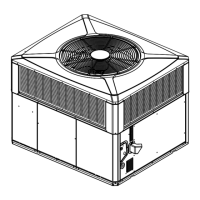26
18-BG07D1-1B-EN
HHeeaatt PPuummpp HHeeaattiinngg SShhuutt DDoowwnn
Place the system mode to OFF or adjust the heating
setpoint below the room temperature.
Gas Furnace Heating Cycle
In addition to the heat pump controls, these units are
equipped with a solid-state ignition control that lights
the burners each time the thermostat calls for heat. The
burners are extinguished during the OFF cycle.
NNoottee:: See the section on "Sequence of Operation" for a
description of the heating operating sequence.
The gas heating section of the unit can be started using
the following procedure:
1. Be sure the thermostat is configured to power up in
the Off mode, or be prepared to change the system
mode to Off just as soon as power is applied to the
thermostat in the steps below.
a. Turn the main shutoff valve on the gas supply
line ON.
b. Turn or switch the manual valve on the
combination gas valve ON position.
c. Be sure the burner compartment access panel is
in place.
d. Turn on the electrical power to the unit.
e. Change the thermostat mode to Emergency
Heat and adjust the heating setpoint slightly
above the room temperature.
2. When the thermostat calls for heat, the system
operates as follows:
a. The combustion blower is energized.
b. The pressure switch is closed.
c. The gas valve opens and the ignitor lights the
burner.
d. Allow the thermostat to cycle on and off a few
times in Emergency Heat mode to check out the
control system and burner operation
characteristics. For the *CONT802 and
*CONT803 Comfort Controls if the call for heat
lasts longer than 10 minutes, these controls will
transition to high fire automatically.
3. With the burners operating, check the manifold
pressure with a manometer. Do not exceed
recommended pressures.
4. Adjust the unit to obtain an air temperature rise
with that specified on the unit nameplate.
NNoottee:: For manifold pressures and orifice sizes for
gas with other BTU ratings, contact the local
gas utility. Manifold pressure should be 1.8
(low) to 3.5 (high) inches water column (+0.1).
Input must nnoott exceed the value shown on
the nameplate.
5. Set the thermostat at the desired temperature
setting and the unit will function automatically.
Starting the Unit in the Gas Heating
Mode
1. Check to make sure all grilles and registers are open
and all unit access doors are closed before start-up.
2. Purge the gas supply line of air by opening the
union ahead of the unit. When the odor of gas is
detected, retighten the union and wait five (5)
minutes before proceeding.
3. Open the main gas valve(s) and turn on the unit
power supply.
4. Set the thermostat mode to Emergency Heat and
adjust the heating setpoint slightly above the room
temperature.
5. The combustion blower motor should energize. The
main burners should light within 20-25 seconds.
Initial start may be delayed somewhat if the unit
has not been purged and air is trapped in the gas
line.
NNoottee:: Blue smoke produced by the heat exchanger
during the initial burner firing is caused by a
thin film of oil on the surface of the heat
exchanger. This oil will burn off quickly.
6. Allow the thermostat to cycle on and off a few times
at a rate of not more than once every thirty (30)
seconds. Check both the control operation and the
burner operating conditions.
7. Increase the heating setpoint significantly so that
the thermostat will transition to high fire
automatically. For the *CONT802 and *CONT803
Comfort Controls, there is a 10 minute delay before
the transition occurs. Make the following manifold
pressure check on high fire.
Manifold Pressure
1. Connect a manometer to the pressure tap at the
outlet side of the unit’s gas valve. Read the
manifold pressure with the main burners firing. See
figure 16, page 17.
2. If the manifold pressure reading does not match the
value indicated on the unit nameplate, the unit
pressure regulator must be adjusted as follows:
a. Remove the cover screw on the gas regulator
located on the front side of the unit’s gas valve.
b. Turn the adjusting screw clockwise to increase
manifold pressure or counterclockwise to
decrease manifold pressure.
3. Check the temperature rise during furnace
operation to insure that it falls within the range
specified on the unit nameplate.
4. If the temperature rise noted is outside of the
specified limits, adjust the indoor airflow to cause
the temperature rise of the heat exchanger to fall
within the required range.
UUnniitt SSttaarrttuupp

